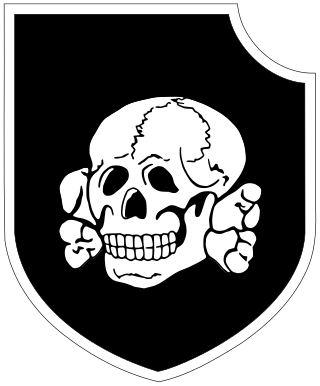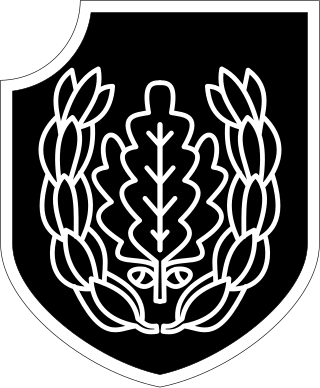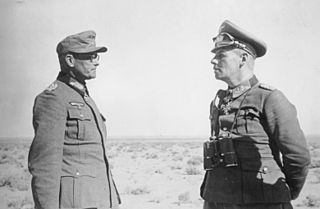
The Waffen-SS was the combat branch of the Nazi Party's paramilitary Schutzstaffel (SS) organisation. Its formations included men from Nazi Germany, along with volunteers and conscripts from both German-occupied Europe and unoccupied lands. It was disbanded in May 1945.

Felix Martin Julius Steiner was a German SS commander during the Nazi era. During World War II, he served in the Waffen-SS, the combat branch of the SS, and commanded several SS divisions and corps. He was awarded the Knight's Cross of the Iron Cross with Oak Leaves and Swords. Together with Paul Hausser, he contributed significantly to the development and transformation of the Waffen-SS into a combat force made up of volunteers and conscripts from both occupied and un-occupied lands.

The SS Division Hitlerjugend or 12th SS Panzer Division "Hitlerjugend" was a German armoured division of the Waffen-SS during World War II. The majority of its junior enlisted men were drawn from members of the Hitler Youth, while the senior NCOs and officers were from other Waffen-SS divisions.

Wilhelm Bittrich was a high-ranking Waffen-SS commander of Nazi Germany. Between August 1942 and February 1943, Bittrich commanded the SS Cavalry Division Florian Geyer, in rear security operations in the Soviet Union. From July 1944 until the end of the war Bittrich commanded the 2nd SS Panzer Corps in Normandy, during Market Garden and in Hungary.

A Panzer division was one of the armored (tank) divisions in the army of Nazi Germany during World War II. Panzer divisions were the key element of German success in the blitzkrieg operations of the early years of World War II. Later the Waffen-SS formed its own panzer divisions, and the Luftwaffe fielded an elite panzer division: the Hermann Göring Division.

The 3rd SS Panzer Division "Totenkopf" was an elite division of the Waffen-SS of Nazi Germany during World War II, formed from the Standarten of the SS-TV. Its name, Totenkopf, is German for "death's head" – the skull and crossbones symbol – and it is thus sometimes referred to as the Death's Head Division.

The 2nd SS Panzer Division Das Reich or SS Division Das Reich was an elite division of the Waffen-SS of Nazi Germany during World War II, formed from the regiments of the SS-Verfügungstruppe (SS-VT). The division served during the invasion of France and took part in several major battles on the Eastern Front, including in the Battle of Prokhorovka against the 5th Guards Tank Army at the Battle of Kursk. It was then transferred to the West and took part in the fighting in Normandy and the Battle of the Bulge, ending the war fighting the Soviets in Hungary and Austria. The division committed the Oradour-sur-Glane and Tulle massacres along with others on the Eastern Front.

The 5th SS Panzer Division Wiking or SS Division Wiking was an infantry and later an armoured division among the thirty-eight Waffen-SS divisions of Nazi Germany. During World War II, the division served on the Eastern Front. It surrendered on 9 May 1945 to the American forces in Austria.

The 9th SS Panzer Division "Hohenstaufen" was a Waffen-SS armoured division of Nazi Germany during World War II. It participated in battles on both the Eastern and Western Fronts. The division was activated in December 1942. Many of the men of the division were young German conscripts, with a cadre of NCOs and staff from the SS Division Leibstandarte and other Waffen SS divisions. Hohenstaufen took part in the relief of German forces in the Kamenets-Podolsky pocket, the Normandy battles, Operation Market Garden, the Ardennes Offensive and Operation Spring Awakening. The division surrendered to the United States Army on 8 May 1945, at Steyr.

The 10th SS Panzer Division "Frundsberg" was a German Waffen-SS armoured division during World War II. The division's first battles were in Ukraine in April 1944. Afterwards, the unit was then transferred to the west, where it fought the Allies in France and at Arnhem. The division was moved to Pomerania, then fought south east of Berlin in the Lusatian area until the end of the war.

Ernst Barkmann was a German tank commander in the Waffen-SS of Nazi Germany during World War II. He is known for the actions undertaken at “Barkmann’s Corner", in which his unit halted a U.S. Army armoured advance in Normandy on 27 July 1944, for which he received the Knight's Cross of the Iron Cross.

The 16th SS Panzergrenadier Division "Reichsführer-SS" was a motorised infantry formation in the Waffen-SS of Nazi Germany during World War II.

37th SS Volunteer Cavalry Division "Lützow" was a German Cavalry division of the Waffen-SS during the Second World War. It was formed in February 1945 from the personnel and equipment of the 8th SS Cavalry Division and the 22nd SS Volunteer Cavalry Division. In addition to this, many under-age German, Hungarian and 'Volksdeutsche' helped make up the division. The division was intended to have three cavalry regiments comprising two battalions each, however, due to the inadequate amount of men and equipment it could only field two understrength regiments as its main combat units. The division was initially commanded by SS-Oberführer Waldemar Fegelein until March when he was replaced by SS-Standartenführer Karl Gesele. The unit saw action against the Soviets as a part of the 6th Panzer Army during the final weeks of the war, before surrendering to Americans in Austria in May 1945. It was named after the Prussian general Adolf von Lützow.
The 102nd Heavy SS Panzer Battalion was a German heavy tank battalion of the Waffen-SS during World War II. It fought as part of the II SS Panzer Corps during the Battle of Normandy and was nearly destroyed. Renumbered as 502nd Heavy SS Panzer Battalion in late 1944, the unit was destroyed in the Halbe Pocket in Spring 1945.

Alfred Ritter von Hubicki was a Hungarian-born general in the Wehrmacht of Nazi Germany during World War II.

Walther von Hünersdorff was a German general during World War II who commanded the 6th Panzer Division. He was a recipient of the Knight's Cross of the Iron Cross with Oak Leaves and was killed during the Battle of Kursk.
Erpo Freiherr von Bodenhausen was a German general who commanded the 12th Panzer Division during World War II. He was a recipient of the Knight's Cross of the Iron Cross of Nazi Germany. Bodenhausen committed suicide on 9 May 1945 in the Courland Pocket.

Karl Böttcher was a German general in the Wehrmacht during World War II who commanded several divisions. He was a recipient of the Knight's Cross of the Iron Cross.
J.J. Fedorowicz Publishing is a Canadian publishing house that specialises in literature on the German armed forces of the World War II era. Its authors are both popular history writers such as Paul Carell and Franz Kurowski, along with the war-time veterans, including Kurt Meyer of the SS Division Hitlerjugend and Otto Weidinger of the SS Division Das Reich.















